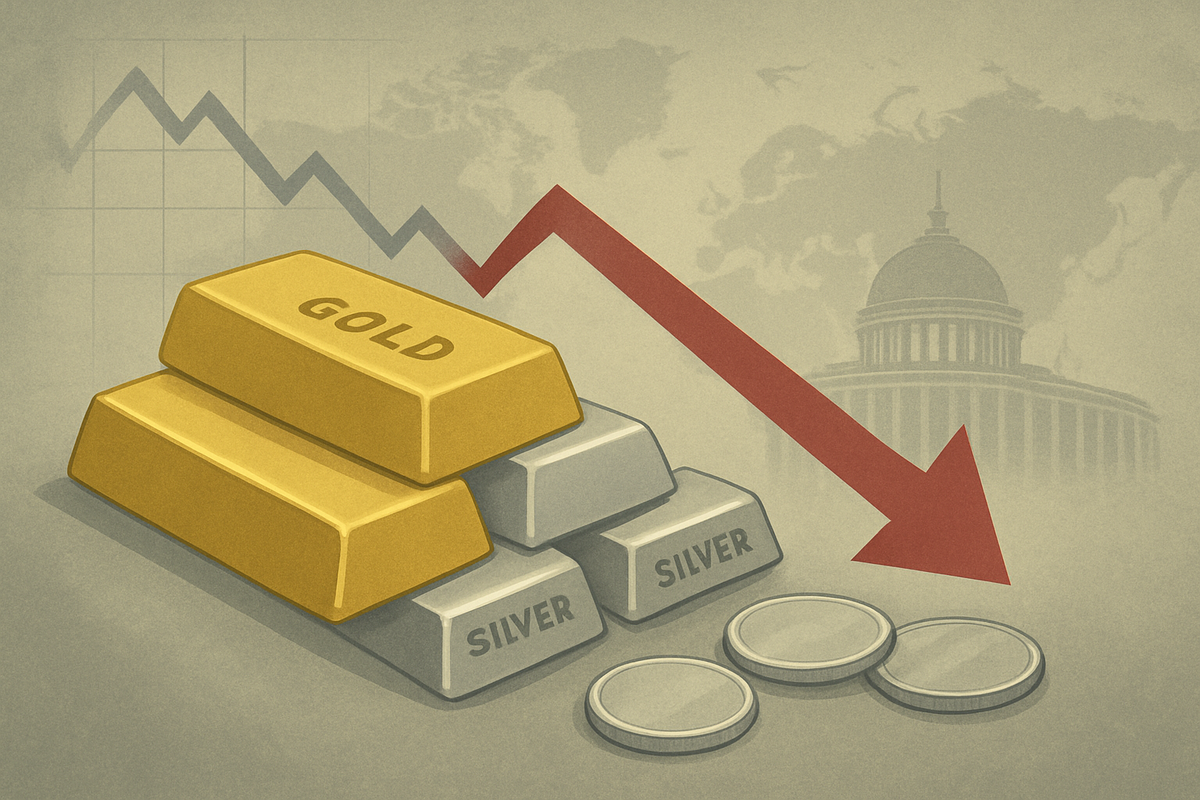
The Indian bullion market has witnessed a dramatic downturn, with gold prices experiencing a precipitous fall of ₹9,356 per 10 grams and silver plummeting by over ₹4,000 per kilogram. This sharp correction, observed in the week leading up to October 24, 2025, comes on the heels of record-high valuations for both precious metals and is primarily attributed to a confluence of weak global cues that have shifted investor sentiment away from safe-haven assets.
The immediate implications for the domestic market are significant, ranging from widespread profit booking by investors to a natural cooling of physical demand following the intense festive season. While the dip offers a potential entry point for some buyers, it has also ushered in a period of heightened volatility, prompting analysts to advise caution for short-term traders as the market seeks a new equilibrium.
Unpacking the Steep Decline: A Week of Market Turmoil
The recent collapse in gold and silver prices marks a pivotal moment for the Indian bullion market, following an extended period of unprecedented gains throughout 2025. Gold, which had soared to an all-time high of ₹1,30,874 per 10 grams on October 17, swiftly retreated to ₹1,21,518 by October 24, registering a substantial weekly decline. Silver mirrored this downward trajectory, shedding over ₹4,000 per kilogram to settle at ₹1,47,033, a staggering fall of ₹31,067 from its recent peak. This rapid unwinding of gains underscores the sensitivity of precious metals to shifts in global economic and geopolitical landscapes.
Several international factors converged to catalyze this sharp correction. A primary driver was widespread profit booking as investors capitalized on the record highs, triggering a natural market adjustment. Furthermore, an easing of geopolitical tensions, including promising developments in US-China trade negotiations and renewed optimism regarding India-US trade relations, diminished the appeal of traditional safe-haven assets like gold and silver. This encouraged a rotation of capital towards riskier, higher-yield assets such as equities. The strengthening US dollar also played a crucial role, making dollar-denominated commodities more expensive for international buyers and consequently dampening demand.
Adding to the bearish sentiment were cues from the US Federal Reserve. Speculation surrounding potential delays in interest rate cuts, coupled with anticipation of upcoming US Consumer Price Index (CPI) data and future central bank policy updates, created an atmosphere of caution among investors. For silver, its dual identity as both an investment and an industrial metal meant it was also impacted by reduced industrial demand from key sectors like electronics and solar energy, contributing to its even sharper correction compared to gold. Domestically, the conclusion of the Indian festive season, including Dhanteras and Diwali, naturally led to a post-festival slowdown in physical demand, exacerbating the price fall.
Companies Navigating the Volatile Waters
The dramatic fall in gold and silver prices presents a mixed bag of fortunes for various players in the financial markets and related industries. Companies involved in the extraction and processing of precious metals, such as Hindustan Zinc (NSE: HINDZINC), a major silver producer, could see their revenues and profitability impacted if the lower prices persist, especially if their operational costs remain elevated. Similarly, investors and traders who entered the market at the recent peak face immediate losses or significantly reduced gains.
Jewelry retailers, a significant segment of the Indian market, also face immediate challenges. Those with substantial inventory purchased at higher prices might experience inventory valuation losses or be compelled to reduce margins to clear stock. However, in the medium to long term, this price correction could prove beneficial for prominent jewelry chains like Titan Company (NSE: TITAN) and Kalyan Jewellers (NSE: KALYANJEWEL). Lower gold and silver prices could stimulate renewed consumer demand, particularly after the festive season rush, potentially leading to increased sales volumes and allowing these companies to replenish their inventory at more favorable costs, ultimately improving future margins.
Furthermore, the price fluctuations have implications for financial instruments tied to precious metals. The India Bullion and Jewellers Association (IBJA) rates, which exclude GST, making charges, and jeweler's margins, are crucial benchmarks. The Reserve Bank of India (RBI) utilizes these rates for determining the value of Sovereign Gold Bonds (SGBs) and for gold loan pricing by various banks. A dip in prices could affect the current redemption values of SGBs but might offer more attractive entry points for new SGB issues. For banks, a decrease in gold collateral value could necessitate margin calls for existing gold loans or impact the loan-to-value ratios for new offerings, though a more stable, albeit lower, price environment can reduce extreme volatility risks.
Broader Implications and Market Realignments
The recent downturn in gold and silver prices is more than just a momentary blip; it reflects broader shifts in global financial market sentiment and commodity trends. The rotation of capital from safe-haven assets to riskier ventures signals an overall increase in investor confidence, driven by perceived improvements in geopolitical stability and economic outlooks. This trend is further amplified by the strengthening US dollar, which often acts as a counterweight to commodity prices. The market's intense focus on the US Federal Reserve's monetary policy, particularly the timing of potential interest rate adjustments, underscores the immense influence of central bank actions on global liquidity and asset valuations.
The ripple effects of this event could extend beyond the bullion market. A sustained shift towards risk-on assets might influence other commodity markets, potentially impacting energy and industrial metal prices. Currency markets will also be closely watching the US dollar's trajectory, as its strength continues to exert pressure on other major currencies and emerging market assets. Historically, corrections following prolonged rallies are a natural feature of commodity cycles, often seen when underlying economic conditions or geopolitical tensions ease. This current situation draws parallels to past periods where a strong dollar environment and reduced global uncertainties led to declines in precious metal valuations.
From a regulatory and policy perspective, the volatility in IBJA rates directly impacts the pricing mechanisms for financial products like SGBs and gold-backed loans in India. The RBI and other financial institutions will need to closely monitor these movements to ensure stability and appropriate risk management. Furthermore, sustained domestic price volatility could influence government policies regarding gold imports and exports, as policymakers aim to manage trade balances and support the local jewelry industry. The event serves as a reminder of the interconnectedness of global financial markets and the rapid transmission of international cues to domestic asset prices.
What Comes Next: Navigating Uncertainty and Opportunity
Looking ahead, the immediate future for gold and silver prices appears to be characterized by continued volatility. Analysts anticipate further fluctuations as the market digests the recent shifts and awaits clearer signals from global economic indicators and central bank policies. Short-term investors are advised to exercise extreme caution, with a close watch on upcoming US CPI data and any pronouncements from the US Federal Reserve regarding interest rates. These events are likely to be key determinants of market direction in the coming weeks.
In the long term, however, many experts maintain a positive outlook for both gold and silver. Despite the recent correction, these precious metals are still widely regarded as valuable hedges against persistent inflation and broader global economic uncertainties. Sustained buying by central banks globally is also expected to provide an underlying floor for prices, offering a degree of support in the months ahead. This dip could therefore represent a strategic buying opportunity for long-term investors looking to diversify their portfolios and protect against future economic headwinds.
Market participants, including jewelers and investment firms, may need to implement strategic pivots. Jewelers might adjust their inventory management and pricing strategies to align with the new market realities, potentially focusing on increasing sales volumes through competitive pricing. Investors, on the other hand, might rebalance their portfolios, allocating capital based on their risk appetite and long-term financial goals. The coming months will present both challenges in navigating the uncertain environment and opportunities for those who can identify and capitalize on market dislocations, with the potential for stabilization after this significant correction.
A Market in Flux: Key Takeaways and Future Watch
The sharp correction in gold and silver prices in the Indian domestic bullion market, driven by a confluence of weak global cues and cooling post-festive demand, marks a significant recalibration for precious metals. Key takeaways include the profound impact of profit booking, easing geopolitical tensions, a strengthening US dollar, and anticipatory moves ahead of US Federal Reserve announcements. These factors collectively triggered a rapid unwinding of the record gains witnessed earlier in 2025.
Moving forward, the market is expected to remain volatile in the short term, but a generally positive long-term outlook persists, underpinned by gold and silver's intrinsic value as inflation hedges and continued central bank accumulation. This event serves as a crucial reminder that even assets perceived as safe havens are not immune to significant corrections, especially after prolonged rallies. It underscores the dynamic interplay between global macroeconomic factors, geopolitical developments, and domestic market sentiment.
For investors, the coming months will demand vigilance. Monitoring US CPI data, the US Federal Reserve's interest rate decisions, and broader geopolitical developments will be paramount. Additionally, observing central bank gold buying trends and the resurgence of domestic demand during future festive seasons will provide crucial insights into the market's trajectory. While the recent downturn presents challenges, it also offers a valuable lesson in market cycles and potential opportunities for those with a long-term perspective and a keen eye on global indicators.
This content is intended for informational purposes only and is not financial advice







